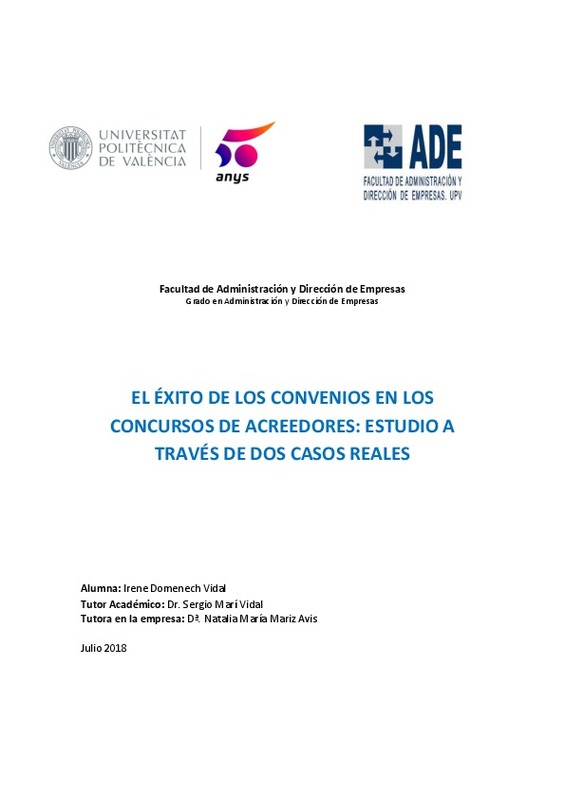|
Resumen:
|
[ES] La grave crisis económica sufrida por España en los últimos años, ha provocado la insolvencia de numerosas empresas, abocando al procedimiento concursal a unas 50.000 sociedades entre 2007 y 2016. Las soluciones a ...[+]
[ES] La grave crisis económica sufrida por España en los últimos años, ha provocado la insolvencia de numerosas empresas, abocando al procedimiento concursal a unas 50.000 sociedades entre 2007 y 2016. Las soluciones a este procedimiento contempladas en la ley son la liquidación y el convenio, siendo considerada esta última como la solución normal, puesto que permite la continuidad de la actividad de las empresas. Sin embargo, la realidad es que más del 90% de los concursos terminan en liquidación, lo cual tiene graves consecuencias para el tejido empresarial. A la vista de este hecho, el objetivo del presente TFG es analizar los factores que determinan el éxito o fracaso empresarial, tras la aprobación del convenio. Con este propósito se estudiarán dos casos reales. Se trata de dos empresas, para las que inicialmente parecía factible la continuación de su actividad mediante el convenio, y sin embargo solo una de ellas pudo continuar con su actividad, mientras que la segunda tuvo que acudir finalmente a liquidación. El trabajo se estructura en dos partes; en la primera se introduce un marco teórico con el fin de ilustrar los aspectos más significativos del Concurso de Acreedores, la Ley Concursal y las soluciones que esta prevé. En la segunda parte, de carácter práctico, se estudiarán las principales características de las dos empresas seleccionadas y de sus respectivos sectores, a fin de comprender las causas que las llevan a solicitar el concurso y en qué situación llegan a este. Posteriormente, se analizarán los hechos que se desarrollan tras el convenio, prestando especial atención a la influencia de la gestión de estas empresas durante el proceso, lo que nos llevará a determinar por qué finalmente la continuación de la actividad solo fue posible para una de ellas.
[-]
[EN] The severe economic crisis suffered by Spain in recent years years has caused the insolvency of many companies, leading to bankruptcy to around 50,000 of them, from 2007 to 2016. The solutions to this procedure ...[+]
[EN] The severe economic crisis suffered by Spain in recent years years has caused the insolvency of many companies, leading to bankruptcy to around 50,000 of them, from 2007 to 2016. The solutions to this procedure contemplated in the law are reorganization and agreement, the latter being considered as the normal solution, since it allows the continuity of the businesses' activity. Nevertheless, in reality more than 90% of the bankruptcies result in liquidation, which has serious consequences for the economy.
Taking this fact into account, the aim of this study is to analyze the factors that determine the the business success or failure, after the approval of the proposed agreement. For this purpose, two real cases will be studied. These are two companies, for which initially the continuation of their activity through the agreement seemed feasible, however only one of them was able to continue with their activity, while the second had to resort to liquidation.
The work is structured in two parts; In the first one, a theoretical framework is introduced to illustrate the most significant aspects of the bankruptcy procedure, the Bankruptcy Law and the solutions it contemplates.
In the second part, of a practical nature, the main characteristics of the two selected companies and their respective sectors will be studied, in order to understand the causes that lead them to bankruptcy and in what situation they reach it. Subsequently, the events occurred after the agreement will be analyzed, paying special attention to the influence of the management of these companies during the process, which will lead us to determine why finally the continuation of the activity was only possible for one of them.
[-]
|







